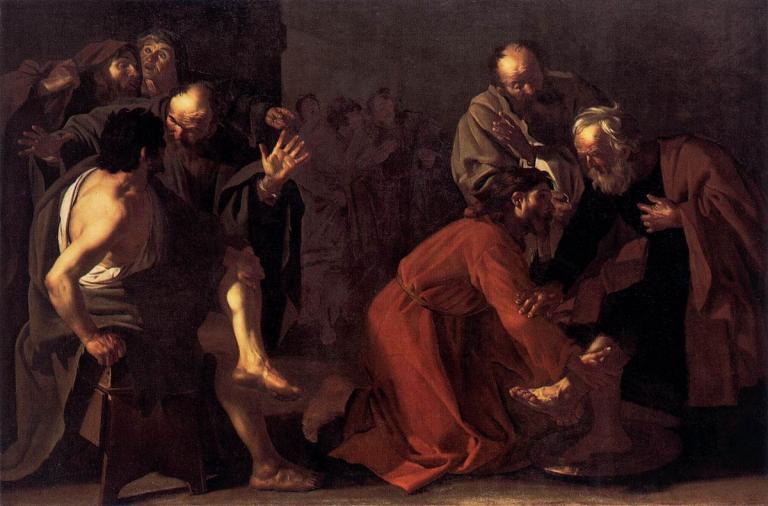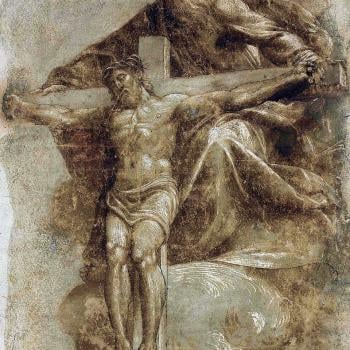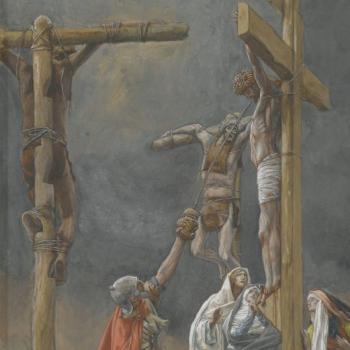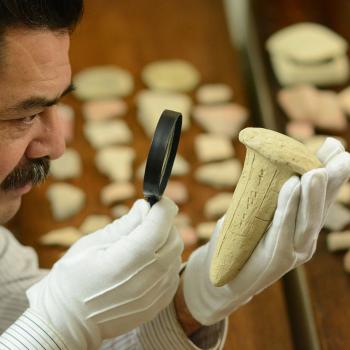
On Maundy Thursday, we remember Jesus’ Last Supper with his disciples where he washed their feet, followed by final instructions to them and his high priestly prayer. Together they serve as the tactical moves for the Lord’s last stand against his adversaries.
Now if you were preparing for battle with your enemies, wouldn’t you be padding the upper room, lower rooms and surrounding premises with sandbags while stockpiling ammunition? In contrast, Jesus prepares for his last stand with a family meal, a foot washing, a farewell discourse,[1] and intimate prayer to his Heavenly Father (See John 13-17). Given Jesus’ Passover sacrifice of himself that the church remembers on Good Friday to bring liberation from bondage in Egypt or Empire and his resurrection from the dead on Easter Sunday, what transpired in his last stand is everlasting. Thus, we are called to live into this everlasting kingdom reality signified by Maundy Thursday. What does it entail for us? This entry will provide an answer to the question.
The United States prizes autonomy and is a fast-food society. As a result, it is easy to discount family meals and hospitality. And so, we may easily bypass what occurred on Maundy Thursday as nothing more than quaint and dispensable. To the contrary, it is qualitatively all-important and indispensable for the Christian movement and what transpired on Good Friday. N.T. Wright has this to say:
When Jesus wanted to explain to his followers what his forthcoming death was all about, he did not give them a theory, a model, a metaphor, or any other such thing; he gave them a meal, a Passover meal.[2]
Many people claim that the meal was the equivalent of the Passover Seder.[3] On this view, Jesus is the head of his family made up of his followers. The only difference is that this head of the home and rabbi offers his own body and blood as the sacrificial lamb, which is signified by the bread that he breaks and wine that he pours out at the meal.
John’s Gospel is the only canonical gospel account that does not record the institution of the Lord’s Supper on Maundy Thursday. John’s Gospel is also the only canonical gospel that records the foot washing. Most of us have never had someone wash our feet at a meal, and likely never by the head of the home or table. But just as Jesus offers himself as the Passover sacrifice (Luke 22:14-20), so he washes his followers’ feet during the supper:
Now before the Feast of the Passover, when Jesus knew that his hour had come to depart from this world to the Father, having loved his own who were in the world, he loved them to the end. During supper, when the devil had already put it into the heart of Judas Iscariot, Simon’s son, to betray him, Jesus, knowing that the Father had given all things into his hands, and that he had come from God and was going back to God, rose from supper. He laid aside his outer garments, and taking a towel, tied it around his waist. Then he poured water into a basin and began to wash the disciples’ feet and to wipe them with the towel that was wrapped around him (John 13:1-5; ESV).
Jesus’ unassuming act was too much for Peter. At first, he refused to let Jesus wash his feet (John 13:6, 8). But given our culture of familiarity with the passage and our culture in which familiarity easily breeds contempt, we may not find the foot washing so radical and feel we are entitled to Jesus stooping low to tend to us. But it is radical and momentous. Again, here’s Wright:
Within the gospels’ recounting of that ultimate Passover, one scene stands out with special poignancy and power. John’s gospel displays deft artistry and fathomless theology throughout, but especially in the footwashing scene in chapter 13. In a few lines we glimpse a tableau both intimate and touching and scary and dangerous. Having begun his gospel with the all-creative Word becoming flesh and revealing God’s glory, John begins the shorter second half with an acted parable of the same thing. Jesus removes his outer garments and kneels down to wash the disciples’ feet, summing up all that is to come in this act of divine humility, of loving redemption, of cleansing for service. For John, as indeed throughout the New Testament, Jesus’ vocation to rescue the world from its plight, and in so doing to reveal the divine glory in action, is focused, symbolized, encoded in an action simultaneously dramatic, fraught with cosmic significance, and gentle, tender with human emotion. If you want to understand the great mysteries of Christian theology, of Trinity, Incarnation, and atonement itself, you could do worse than spend time with this scene.[4]
Jesus calls on his followers to care for one another in the same manner (John 13:12-17). If we thought Jesus went too far with washing his disciples’ feet, we may think he went beyond the breaking point with calling them to care for one another in the same servant-like manner. Even if we like the title of servant-leader or lead servant, we easily take offense if we’re not esteemed in ministry. My colleague Albert Baylis put it well when he remarked: we all want to be called servant leaders until someone treats us like one.
The challenge to our sense of entitlement does not end there. Not only does Jesus wash Peter’s feet, but also he washes the feet of Judas, whom the Lord knew would betray him that very night. Jesus breaks bread with the very one who would hand him over to be broken and poured out in death. However, rather than protect himself, Jesus offers himself as a willing sacrifice in order to destroy hatred with love and bring new life.
If we had more time and space, we would discuss the farewell discourse recorded in chapters 14-16 and Jesus’ high priestly prayer in chapter 17. The church recalls these subjects and the other themes noted here on Maundy Thursday. In each and every one of them—from the family meal and foot washing to the farewell discourse and prayer to his Father as well as the betrayal—Jesus models humility, vulnerability, and the desire for relational intimacy that mark his kingdom glory and vision for our lives as his kingdom community.
May we follow suit. We have every reason to be inspired by Jesus’ glorious, all-powerful example of holy and pure love on Maundy Thursday and Good Friday, and his resurrection from the dead on Easter Sunday. As a result of the bodily resurrection, what transpired at Jesus’ last stand in his battle to the death with his enemies inaugurated the eternal kingdom reality. Humility, vulnerability and relational intimacy win out in the end. Will we live into this reality or go back to the way things used to be before Jesus’ last and everlasting stand?
_______________
[1]For further reflection on this theme, see Paul Louis Metzger, The Gospel of John: When Love Comes to Town, Resonate Series (Downers Grove: InterVarsity Press, 2010), pages 167-171.
[2]N.T. Wright, The Day the Revolution Began: Reconsidering the Meaning of Jesus’s Crucifixion (New York: HarperOne, 2016), page 182.
[3]For a treatment of parallels between the Last Supper and the Passover Seder, see Joachim Jeremias, The Eucharistic Words of Jesus, 3rd ed. (London: SCM Press, 1966), pages 42–61. For an overview as well as critique of the Last Supper as a Passover Seder, see Jonathan Klawans, “Was Jesus’ Last Supper a Seder?” Bible History Daily, April 19, 2019; https://www.biblicalarchaeology.org/daily/people-cultures-in-the-bible/jesus-historical-jesus/was-jesus-last-supper-a-seder/ (accessed on 3/23/2020).
[4]N.T. Wright, “The Royal Revolution: Fresh Perspectives on the Cross,” Calvin College January Series, January 24, 2017; https://ntwrightpage.com/2017/01/30/the-royal-revolution-fresh-perspectives-on-the-cross/ (accessed on 3/23/2020).












